The Smart City 智慧城市
- 格式:pptx
- 大小:4.10 MB
- 文档页数:20
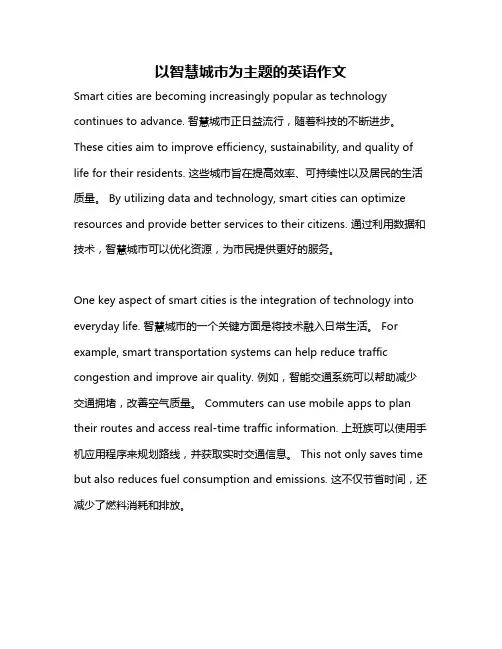
以智慧城市为主题的英语作文Smart cities are becoming increasingly popular as technology continues to advance. 智慧城市正日益流行,随着科技的不断进步。
These cities aim to improve efficiency, sustainability, and quality of life for their residents. 这些城市旨在提高效率、可持续性以及居民的生活质量。
By utilizing data and technology, smart cities can optimize resources and provide better services to their citizens. 通过利用数据和技术,智慧城市可以优化资源,为市民提供更好的服务。
One key aspect of smart cities is the integration of technology into everyday life. 智慧城市的一个关键方面是将技术融入日常生活。
For example, smart transportation systems can help reduce traffic congestion and improve air quality. 例如,智能交通系统可以帮助减少交通拥堵,改善空气质量。
Commuters can use mobile apps to plan their routes and access real-time traffic information. 上班族可以使用手机应用程序来规划路线,并获取实时交通信息。
This not only saves time but also reduces fuel consumption and emissions. 这不仅节省时间,还减少了燃料消耗和排放。
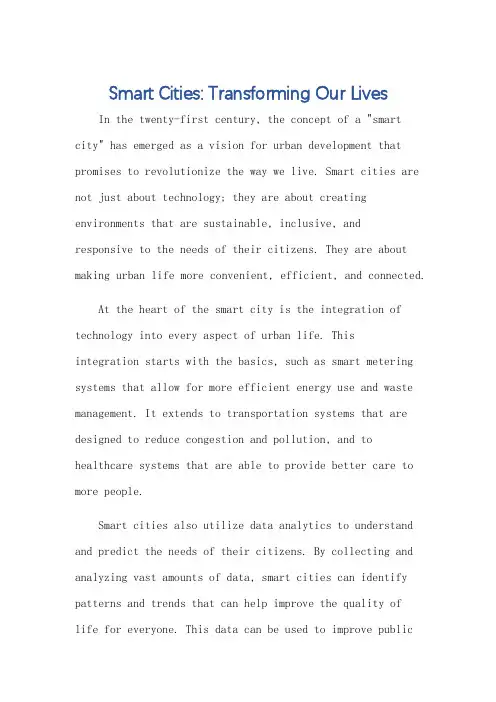
Smart Cities: Transforming Our LivesIn the twenty-first century, the concept of a "smart city" has emerged as a vision for urban development that promises to revolutionize the way we live. Smart cities are not just about technology; they are about creating environments that are sustainable, inclusive, andresponsive to the needs of their citizens. They are about making urban life more convenient, efficient, and connected. At the heart of the smart city is the integration of technology into every aspect of urban life. Thisintegration starts with the basics, such as smart metering systems that allow for more efficient energy use and waste management. It extends to transportation systems that are designed to reduce congestion and pollution, and to healthcare systems that are able to provide better care to more people.Smart cities also utilize data analytics to understand and predict the needs of their citizens. By collecting and analyzing vast amounts of data, smart cities can identify patterns and trends that can help improve the quality oflife for everyone. This data can be used to improve publicservices, plan infrastructure projects, and even develop new policies and strategies.The benefits of smart cities are numerous. They can help reduce environmental pollution and energy consumption, while also improving the efficiency of public services. They can create safer, more connected communities, and they can provide better opportunities for education and healthcare. Most importantly, smart cities can make life easier and more convenient for citizens, allowing them to spend less time on everyday tasks and more time enjoying the things that matter most.However, the transition to a smart city is not without its challenges. It requires significant investment in technology and infrastructure, as well as a commitment to creating inclusive and sustainable environments. It also requires the involvement and participation of citizens, who need to be educated and engaged in the process of urban transformation.Despite these challenges, the potential of smart cities is immense. They offer a vision for the future of urbanlife that is more connected, efficient, and sustainable. Aswe continue to develop and implement smart city solutions, we have the opportunity to create cities that are not just places to live, but places that enhance the quality of life for everyone.**智慧城市:改变我们的生活**在21世纪,智慧城市的概念作为城市发展的愿景崭露头角,承诺以革命性的方式改变我们的生活方式。
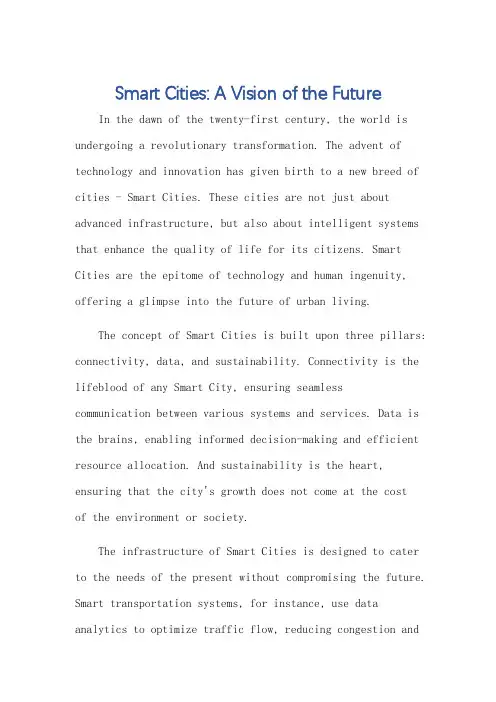
Smart Cities: A Vision of the FutureIn the dawn of the twenty-first century, the world is undergoing a revolutionary transformation. The advent of technology and innovation has given birth to a new breed of cities - Smart Cities. These cities are not just about advanced infrastructure, but also about intelligent systems that enhance the quality of life for its citizens. Smart Cities are the epitome of technology and human ingenuity, offering a glimpse into the future of urban living.The concept of Smart Cities is built upon three pillars: connectivity, data, and sustainability. Connectivity is the lifeblood of any Smart City, ensuring seamless communication between various systems and services. Data is the brains, enabling informed decision-making and efficient resource allocation. And sustainability is the heart, ensuring that the city's growth does not come at the costof the environment or society.The infrastructure of Smart Cities is designed to cater to the needs of the present without compromising the future. Smart transportation systems, for instance, use data analytics to optimize traffic flow, reducing congestion andpollution. Smart grids manage energy consumption, ensuring efficient use of resources and reducing waste. Smart buildings are designed to maximize energy efficiency and provide a comfortable living environment.But the true essence of Smart Cities lies in itsability to create a connected and engaged community.Citizen engagement is key to making cities smart. By involving citizens in the decision-making process, cities can create a more inclusive and responsive environment. Smart Cities also use technology to create platforms for citizen participation, such as online surveys, community forums, and open data portals.The benefits of Smart Cities are numerous. They improve the efficiency of city operations, reduce waste, and enhance the quality of life for citizens. Smart Cities also foster innovation and creativity, attracting talent and investment. And by prioritizing sustainability, SmartCities can help mitigate the negative impacts of urbanization, such as climate change and social inequality. However, the journey to becoming a Smart City is not without challenges. High upfront costs, technologicalbarriers, and privacy concerns are some of the major obstacles. But with the right policies, partnerships, and investments, these challenges can be overcome.In conclusion, Smart Cities offer a vision of thefuture that is both exciting and necessary. They are not just about technology, but also about creating sustainable, inclusive, and connected communities. As we march towards a more interconnected and technologically advanced world, Smart Cities will play a pivotal role in shaping our urban future.**智慧城市:未来的愿景**在21世纪的曙光下,世界正在经历一场革命性的变革。
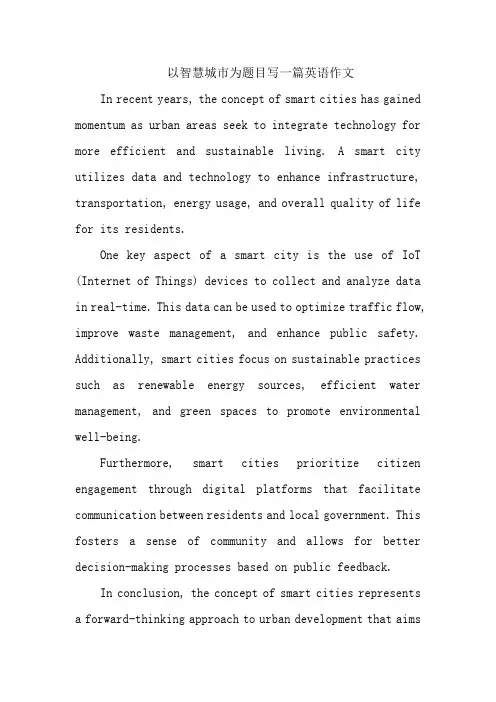
以智慧城市为题目写一篇英语作文In recent years, the concept of smart cities has gained momentum as urban areas seek to integrate technology for more efficient and sustainable living. A smart city utilizes data and technology to enhance infrastructure, transportation, energy usage, and overall quality of life for its residents.One key aspect of a smart city is the use of IoT (Internet of Things) devices to collect and analyze data in real-time. This data can be used to optimize traffic flow, improve waste management, and enhance public safety. Additionally, smart cities focus on sustainable practices such as renewable energy sources, efficient water management, and green spaces to promote environmental well-being.Furthermore, smart cities prioritize citizen engagement through digital platforms that facilitate communication between residents and local government. This fosters a sense of community and allows for better decision-making processes based on public feedback.In conclusion, the concept of smart cities represents a forward-thinking approach to urban development that aimsto create more livable, efficient, and sustainable environments for all residents.中文翻译:近年来,智慧城市的概念在城市地区寻求整合技术以实现更高效、可持续生活方面逐渐兴起。
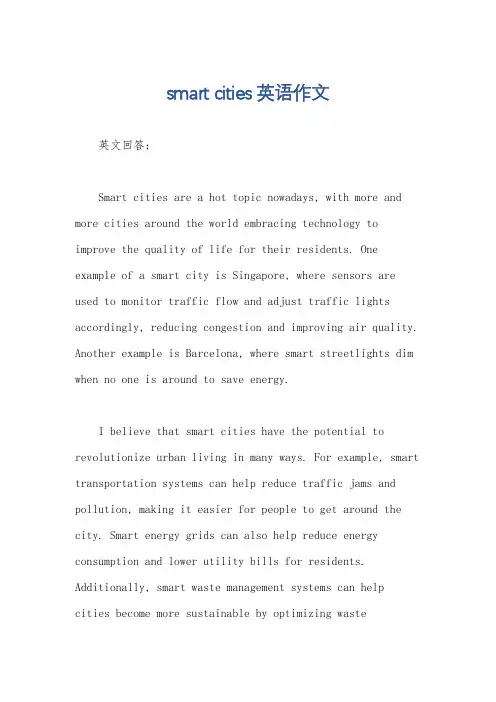
smart cities英语作文英文回答:Smart cities are a hot topic nowadays, with more and more cities around the world embracing technology to improve the quality of life for their residents. One example of a smart city is Singapore, where sensors are used to monitor traffic flow and adjust traffic lights accordingly, reducing congestion and improving air quality. Another example is Barcelona, where smart streetlights dim when no one is around to save energy.I believe that smart cities have the potential to revolutionize urban living in many ways. For example, smart transportation systems can help reduce traffic jams and pollution, making it easier for people to get around the city. Smart energy grids can also help reduce energy consumption and lower utility bills for residents. Additionally, smart waste management systems can helpcities become more sustainable by optimizing wastecollection and recycling processes.However, there are also challenges that come with building smart cities. One major concern is privacy and data security. With so much data being collected by sensors and cameras, there is a risk of this information being misused or hacked. Another challenge is the digital divide, where not everyone has access to the technology needed to benefit from smart city initiatives. It's important forcity planners to address these issues to ensure that smart cities are inclusive and safe for all residents.Overall, I believe that smart cities have the potential to greatly improve our quality of life, but it's important to approach this technology with caution and ensure that it benefits everyone in the community.中文回答:智慧城市是当今热门话题,越来越多的城市在全球范围内采用技术来改善居民的生活质量。

Smart Cities: The Future of UrbanDevelopmentIn the twenty-first century, the concept of smartcities has gained significant momentum, shaping the futureof urban development. As technology continues to advance, cities are embracing innovations to become more efficient, sustainable, and connected. Smart cities integrate various technologies such as the Internet of Things (IoT), big data, artificial intelligence (AI), and cloud computing toimprove the quality of life for citizens, enhance urban management, and foster economic growth.The foundation of smart cities lies in the IoT, which connects various devices and sensors to collect and exchange data. This data, when analyzed effectively, can provide valuable insights into city operations, allowingfor informed decision-making and proactive problem-solving. For instance, smart traffic systems can adjust traffic signals in real-time based on traffic flow data, reducing congestion and improving travel times. Similarly, smart metering systems can monitor and manage energy usage,enabling more efficient resource allocation and cost savings.Artificial intelligence (AI) plays a crucial role in smart cities by processing and analyzing the vast amounts of data generated by the IoT. AI algorithms can predict patterns and trends, enabling proactive responses to potential issues. For instance, AI-powered predictive maintenance systems can identify potential failures in infrastructure such as bridges or roads, allowing for timely repairs and preventing disasters.Cloud computing provides the infrastructure for smart cities, enabling secure storage and access to data from anywhere. This allows for collaboration and coordination among different city departments and agencies, improving the efficiency of urban management. Cloud-based platforms also enable citizens to access city services and information seamlessly, enhancing their engagement with the city.Sustainability is a core aspect of smart city development. Smart cities aim to reduce environmental impacts by promoting renewable energy sources, energy-efficient buildings, and sustainable transportation systems. For instance, smart grids can integrate renewable energy sources such as solar and wind power, balancing supply and demand to reduce waste and emissions.The development of smart cities also fosters economic growth. By improving infrastructure, enhancing theefficiency of city services, and attracting innovative businesses and talents, smart cities create a favorable environment for business development and job creation. This, in turn, generates revenue and taxes for the city, enabling further investments in smart city initiatives.In conclusion, smart cities represent the future of urban development. By integrating technologies such as the IoT, AI, and cloud computing, smart cities are improvingthe quality of life for citizens, enhancing urban management, and fostering economic growth. As technology continues to advance, we can expect smart cities to become more intelligent, sustainable, and connected, shaping the urban landscape of the twenty-first century.**智慧城市:城市发展的未来**在二十一世纪,智慧城市的概念已经获得了巨大的动力,塑造了城市发展的未来。
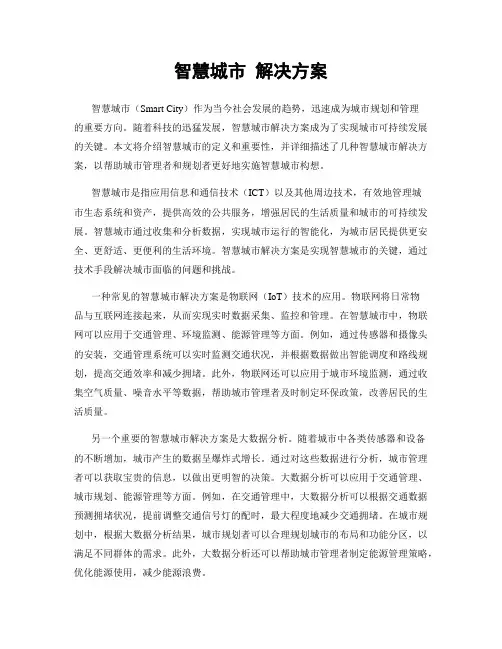
智慧城市解决方案智慧城市(Smart City)作为当今社会发展的趋势,迅速成为城市规划和管理的重要方向。
随着科技的迅猛发展,智慧城市解决方案成为了实现城市可持续发展的关键。
本文将介绍智慧城市的定义和重要性,并详细描述了几种智慧城市解决方案,以帮助城市管理者和规划者更好地实施智慧城市构想。
智慧城市是指应用信息和通信技术(ICT)以及其他周边技术,有效地管理城市生态系统和资产,提供高效的公共服务,增强居民的生活质量和城市的可持续发展。
智慧城市通过收集和分析数据,实现城市运行的智能化,为城市居民提供更安全、更舒适、更便利的生活环境。
智慧城市解决方案是实现智慧城市的关键,通过技术手段解决城市面临的问题和挑战。
一种常见的智慧城市解决方案是物联网(IoT)技术的应用。
物联网将日常物品与互联网连接起来,从而实现实时数据采集、监控和管理。
在智慧城市中,物联网可以应用于交通管理、环境监测、能源管理等方面。
例如,通过传感器和摄像头的安装,交通管理系统可以实时监测交通状况,并根据数据做出智能调度和路线规划,提高交通效率和减少拥堵。
此外,物联网还可以应用于城市环境监测,通过收集空气质量、噪音水平等数据,帮助城市管理者及时制定环保政策,改善居民的生活质量。
另一个重要的智慧城市解决方案是大数据分析。
随着城市中各类传感器和设备的不断增加,城市产生的数据呈爆炸式增长。
通过对这些数据进行分析,城市管理者可以获取宝贵的信息,以做出更明智的决策。
大数据分析可以应用于交通管理、城市规划、能源管理等方面。
例如,在交通管理中,大数据分析可以根据交通数据预测拥堵状况,提前调整交通信号灯的配时,最大程度地减少交通拥堵。
在城市规划中,根据大数据分析结果,城市规划者可以合理规划城市的布局和功能分区,以满足不同群体的需求。
此外,大数据分析还可以帮助城市管理者制定能源管理策略,优化能源使用,减少能源浪费。
智慧城市解决方案还包括智能交通系统、智能建筑、智慧能源管理等多个方面。
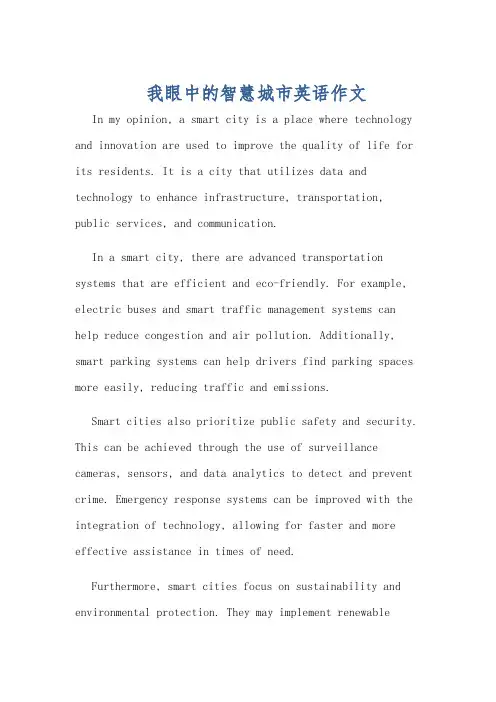
我眼中的智慧城市英语作文In my opinion, a smart city is a place where technology and innovation are used to improve the quality of life for its residents. It is a city that utilizes data and technology to enhance infrastructure, transportation, public services, and communication.In a smart city, there are advanced transportation systems that are efficient and eco-friendly. For example, electric buses and smart traffic management systems can help reduce congestion and air pollution. Additionally, smart parking systems can help drivers find parking spaces more easily, reducing traffic and emissions.Smart cities also prioritize public safety and security. This can be achieved through the use of surveillance cameras, sensors, and data analytics to detect and prevent crime. Emergency response systems can be improved with the integration of technology, allowing for faster and more effective assistance in times of need.Furthermore, smart cities focus on sustainability and environmental protection. They may implement renewableenergy sources, waste management systems, and green infrastructure to reduce their carbon footprint and promote a healthier environment for residents.In terms of public services, smart cities utilizedigital platforms and mobile applications to provide easy access to government services, healthcare, education, and cultural activities. This improves efficiency and convenience for residents.Overall, a smart city leverages technology and data to create a more livable, sustainable, and connected urban environment for its citizens.对我来说,智慧城市是一个利用科技和创新改善居民生活质量的地方。

想象中的智慧城市是样的英语作文全文共3篇示例,供读者参考篇1Imagining the Smart City of TomorrowIn the not-too-distant future, cities around the world will be transformed into smart cities that leverage cutting-edge technology to improve the lives of their residents. These smart cities will be characterized by their efficient use of resources, interconnected infrastructure, and emphasis on sustainability and quality of life.One of the key features of a smart city will be the integration of technology into every aspect of urban life. For example, buildings will be equipped with sensors that monitor energy usage and adjust lighting and climate control systems accordingly. Traffic lights will be synchronized to reduce congestion and emissions, and public transportation systems will be interconnected and autonomous, providing convenient and efficient options for getting around the city.In addition, smart cities will prioritize sustainability and environmental conservation. Green spaces and renewableenergy sources will be abundant, and waste management systems will be optimized to reduce pollution and promote recycling. Residents will have access to real-time air and water quality data, allowing them to make informed decisions about their health and well-being.Furthermore, smart cities will prioritize the well-being of their residents by promoting healthy lifestyles and social connectivity. Parks and recreational areas will be plentiful, and public spaces will be designed to encourage interaction and community engagement. Education and healthcare services will be easily accessible and personalized, utilizing AI and telemedicine to provide high-quality care to all residents.Overall, the smart city of tomorrow will be a vibrant and dynamic environment that prioritizes efficiency, sustainability, and quality of life. By harnessing the power of technology and innovation, cities around the world will be able to create a better future for all of their residents. The possibilities are endless, and the smart city of tomorrow is sure to be an exciting and transformative place to live.篇2Imagining the Smart City of the FutureIn today's rapidly evolving world, the concept of a smart city has gained increasing popularity. A smart city is a city that uses technology to improve the quality of life of its residents and enhance the efficiency of its services. From smart transportation systems to energy-efficient buildings, the possibilities for a smart city are endless. In this essay, I will explore what the imagined smart city of the future might look like.One of the key features of a smart city is its transportation system. Imagine a city where self-driving cars and buses navigate the streets seamlessly, reducing traffic congestion and emissions. Residents can simply input their desired destination into an app, and a self-driving vehicle will arrive to take them there. Additionally, smart traffic lights and sensors can adjust the flow of traffic in real-time, ensuring a smooth and efficient journey for all.In the smart city of the future, energy efficiency is a top priority. Buildings are equipped with smart technology that monitors energy usage and adjusts temperature and lighting accordingly. Renewable energy sources such as solar panels and wind turbines are integrated into the city's infrastructure, providing clean and sustainable power for its residents. Smartgrid technology allows for the efficient distribution of electricity, reducing waste and lowering costs for consumers.Another key aspect of a smart city is its use of data and technology to improve public services. For example, city officials can analyze data from sensors and smart devices to predict and prevent crime, improve healthcare services, and optimize waste management. Residents can access government services and information through a centralized digital platform, making it easier to engage with their local government and participate in decision-making processes.In the imagined smart city of the future, connectivity is essential. High-speed, reliable internet access is available to all residents, enabling them to access information, communicate with others, and participate in the digital economy. Smart sensors and devices are integrated into the city's infrastructure, creating a seamless network that enables real-time data collection and analysis for a wide range of applications.In conclusion, the smart city of the future is a place where technology is harnessed to improve the quality of life for residents, enhance the efficiency of services, and create a sustainable and livable urban environment. While the vision of a smart city may seem like a distant dream, many cities around theworld are already taking steps to incorporate smart technologies into their infrastructure. By working together to overcome challenges and embrace innovation, we can build a better future for all. Let us continue to imagine and strive for the smart city of tomorrow.篇3Imagining the Smart City of the FutureIn the world of constant innovation and technological advancement, the concept of smart cities has become increasingly popular. A smart city is defined as a municipality that uses information and communication technologies to increase operational efficiency, share information with the public, and improve the quality of government services. As we look towards the future, the possibilities for smart cities are endless. Here, we will explore what an imagined smart city of the future might look like.InfrastructureIn the smart city of the future, infrastructure will be seamlessly connected and integrated. Buildings will be equipped with smart sensors and devices to monitor energy consumption and efficiency. Roads and transportation systems will becontrolled by intelligent traffic management systems that reduce congestion and improve traffic flow. Waste management will be optimized through sensors that track and manage waste collection and recycling efforts. In essence, every aspect of the city's infrastructure will be interconnected and intelligent.Public ServicesPublic services in the smart city of the future will be revolutionized by technology. Citizens will have access to a digital platform where they can access information, report issues, and communicate with government officials. Healthcare services will be enhanced through telemedicine and wearable health monitoring devices. Education will be transformed by online learning platforms and interactive digital classrooms. In short, public services will be more efficient, accessible, and responsive to the needs of the community.MobilityMobility will be a key focus in the smart city of the future. Autonomous vehicles will dominate the roads, reducing accidents and improving traffic flow. Public transportation will be efficient and sustainable, with trains and buses running on clean energy sources. Bike-sharing programs and electric scooter rentals will provide residents with alternative and eco-friendlymodes of transportation. Overall, mobility in the smart city of the future will be seamless, convenient, and environmentally friendly.SustainabilitySustainability will be at the core of the smart city of the future. Buildings will be designed with energy-efficient materials and systems to reduce carbon emissions. Renewable energy sources such as solar and wind power will be integrated into the city's grid to provide clean and reliable electricity. Green spaces and urban gardens will be incorporated into the cityscape to promote biodiversity and improve air quality. The smart city of the future will prioritize sustainability to create a healthy and livable environment for its residents.Safety and SecuritySafety and security will be paramount in the smart city of the future. Video surveillance and facial recognition technology will be used to monitor public spaces and prevent crime. Emergency responders will be equipped with real-time data and communication tools to improve response times and effectiveness. Cybersecurity measures will be implemented to protect sensitive information and prevent data breaches. Thesmart city of the future will be a secure and resilient community where residents can feel safe and protected.In conclusion, the smart city of the future will be a dynamic and innovative environment that leverages technology to enhance every aspect of urban life. From infrastructure and public services to mobility and sustainability, the smart city of the future will be a model of efficiency, accessibility, and sustainability. While the vision of a smart city may still be in the realm of imagination, the possibilities for creating a better and smarter future are endless. Let us embrace the potential of smart cities and work towards building a more connected and intelligent world.。

什么是智慧城什么是智慧城?智慧城市(Smart City)是指利用信息技术与物联网技术,以及各种传感器、网络和数据分析等技术手段,为城市的公共管理和市民的生活提供更加高效、便捷和可持续发展的解决方案的城市形态。
智慧城市通过集成多种智能技术,实现城市基础设施和服务的智能化、可持续发展和信息化管理,以提升城市的质量、效率和便捷性。
在智慧城市中,各种设备和系统都可以通过互联网进行连接和通信,形成一个智能的城市网络。
这些设备包括传感器、摄像头、停车场计数器、智能交通信号灯等,以及方式、平板电脑等个人智能设备。
通过这些设备和系统的互联互通,城市可以实时获取各种数据,并对这些数据进行分析和处理,从而实现对城市资源、环境和设施的智能化管理。
在智慧城市中,人们可以通过方式APP等方式获取城市的各种信息和服务,比如交通信息、天气预报、公共服务设施的位置等。
同时,公共服务设施也可以通过智能化的方式为市民提供更加便捷的服务。
比如,智能交通信号灯可以根据实时交通情况进行智能调节,减少交通拥堵;智能停车系统可以提供实时的停车位信息,帮助市民快速找到停车位;智能垃圾桶可以自主地进行垃圾分类和压缩,提高垃圾回收和处理的效率等等。
智慧城市还可以通过智能化的能源管理来实现可持续发展。
通过智能电网和智能能源管理系统,城市可以更加高效地管理和利用能源资源,优化能源分配和供应,降低能源的浪费和排放,提高能源利用效率,从而实现可持续发展的目标。
智慧城市还可以通过智能化的安全管理来提高城市的安全性。
通过智能监控系统和人脸识别技术,城市可以实时监控各个区域的安全状况,及时发现和应对各种安全问题。
同时,市民也可以通过智能安全设备(如智能门锁、智能摄像头等)来提高个人和家庭的安全。
总之,智慧城市是利用信息技术和物联网技术将各种设备和系统互联互通,实现城市基础设施和服务的智能化、可持续发展和信息化管理的城市形态。
智慧城市通过提供高效、便捷和可持续发展的解决方案,可以提升城市的质量、效率和便捷性,改善市民的生活质量,实现城市可持续发展的目标。

智慧城市对企业的作用
智慧城市(Smart City)是智能城市管理理念的延伸,其基础服务的
关键内容包括安全保障、环境保护、文化推广,以及基础设施的优化,结
合信息化和智能化,为城市管理提供协作和全面参与的新模式。
因此,智
慧城市对企业的作用无疑是巨大的。
首先,智慧城市的安全保护能够保护企业的商业稳定性,促进企业和
投资的发展。
智慧城市的安全保护规定明确、遵守法规,能够有效防止犯
罪和不法行为,确保人民群众的安全。
同时,智慧城市重视社会文明、公
共秩序和空气质量等环境保护,实施绿色出行,推行节能减排,管控违法
排污,为企业发展营造良好的营商环境。
其次,智慧城市极大地便利了企业的经营。
智慧城市基础设施的优化,提高了企业的供应链能力,改善了企业管理质量,提高了企业的运营效率。
同时,智慧城市综合利用信息技术,以解决企业的问题,例如节能减排、
推广智能化、贸易管理、库存管理等,使企业在经营中降低了成本,提高
了竞争力。
此外,智慧城市还有助于企业宣传和拓展业务市场。
对智慧城市的理解与认识智慧城市(Smart City)是指借助信息技术、物联网技术和大数据等技术手段,通过智能化、网络化、数字化的方式,实现城市运行和治理的智能化、高效化和便利化。
智慧城市是城市发展的必然趋势,也是解决城市面临的挑战和问题的重要途径之一。
下面将对智慧城市进行理解与认识。
一、智慧城市的概念与特征智慧城市是集信息技术、互联网、物联网、人工智能等多种技术手段于一体的城市管理和发展模式。
其主要特征包括智能化、高效化、绿色化和公众参与。
智能化是指通过信息技术的应用,实现城市基础设施和公共服务的智能化管理和控制。
例如,智能交通系统可以通过实时监测和优化路况,提高交通效率和减少拥堵。
高效化是指通过信息技术的支持,提高城市治理和公共服务的效率和质量。
例如,智能化的城市服务中心可以快速响应居民需求,提供高效便捷的服务。
绿色化是指借助信息技术,优化能源利用和环境保护,实现可持续发展。
例如,智能化的能源管理系统可以实时监测和调节能源使用,降低资源消耗和环境污染。
公众参与是指通过信息技术的支持,增强市民对城市事务的参与和决策。
例如,智慧城市可以通过移动应用和社交媒体平台,让市民参与城市规划、环境保护等活动。
二、智慧城市的应用领域智慧城市的应用领域非常广泛,涵盖了城市交通、环境保护、公共安全、医疗健康、教育文化、社会管理等方面。
在城市交通方面,智慧城市可以通过智能交通信号灯、智能公交车站、智能停车管理等手段,提高交通效率和减少拥堵。
在环境保护方面,智慧城市可以通过智能化的环境监测和管理系统,提高环境保护的效果。
例如,通过实时监测空气质量和水质状况,可以及时采取措施保护环境。
在公共安全方面,智慧城市可以通过智能监控系统、应急指挥中心等手段,提高城市安全防范和应急响应能力。
在医疗健康方面,智慧城市可以通过电子健康档案、智能医疗设备等手段,提高医疗服务的质量和效率。
在教育文化方面,智慧城市可以通过智慧校园、数字图书馆等手段,提供便捷的教育和文化服务。
智慧城市的含义智慧城市的含义⒈引言智慧城市是指利用先进的信息技术,通过对城市各项基础设施和公共服务的智能化、网络化和数字化改造,以提高城市运行效率、提升城市居民生活品质为目标的城市发展模式。
智慧城市的核心理念是将城市各个方面的运行与管理全面智能化,通过数据的收集、分析和应用,实现城市规划、交通管理、环境保护、能源利用等领域的智能决策和优化。
⒉智慧城市的特点⑴智能化管理智慧城市将各类城市设施和服务进行智能化改造,通过传感器、物联网和大数据技术,实现对城市的实时监测、分析和管理。
智慧城市能够自动控制路灯亮度、交通信号灯的配时,及时检测和修复道路损坏,以提高城市的运行效率和安全性。
⑵网络化通信智慧城市建设依赖于高速宽带网络的覆盖和通信设施的建设。
通过建设城市级的通信网络,实现各类城市设施和服务之间的互联互通,为城市居民提供更加便捷的信息服务。
⑶数据驱动决策智慧城市通过大数据技术对城市各类数据进行采集、分析和挖掘,从而为城市决策提供科学依据。
通过对交通流量、环境污染、能源消耗等数据的实时分析,可以优化城市规划和资源利用,提高城市的可持续发展能力。
⑷提升居民生活品质智慧城市通过提供便捷的公共服务和创新的商业模式,提升城市居民的生活品质。
例如,通过智能交通系统和共享出行平台,解决城市交通拥堵问题。
通过智慧健康管理系统,提供个性化的医疗服务。
通过智能家居系统,提供便捷的居家生活体验。
⒊智慧城市的应用领域⑴城市交通智慧城市通过智能交通管理系统,实现交通信号灯的自适应配时、交通流量监测、路况信息发布等功能,从而提高交通运行效率,缓解交通拥堵。
此外,智慧城市还鼓励推广公共交通和共享出行,减少私人汽车使用,降低交通尾气排放,改善空气质量。
⑵城市环境智慧城市通过建设环境监测网络,实时监测和评估城市的环境污染状况,采取相应的措施加以改善。
例如,通过智能化垃圾桶和智能化公厕,实现对垃圾和污水的智能管理和处理。
通过智慧能源管理系统,优化能源利用,减少能源浪费。
智慧城市好处与坏处英语作文English:A smart city, also known as a digital city or intelligent city, utilizes advanced technology and data analysis to enhance the quality of life for its residents. The benefits of a smart city are numerous. Firstly, it improves efficiency and sustainability. Advanced technologies such as smart grids, sensors, and data analytics can help optimize energy consumption, reduce waste, and enhance resource management. This leads to cost savings, better infrastructure, and a greener environment. Secondly, a smart city enables better urban planning and management. Through the use of predictive analytics and real-time data, city officials can make informed decisions regarding traffic management, waste management, public safety, and infrastructure development. This results in improved transportation systems, reduced crime rates, and better public services. Thirdly, a smart city promotes citizen engagement and participation. By providing citizens with access to information, digital services, and platforms for communication, smart cities empower individuals to contribute to the decision-making process and co-create solutions for urban challenges. This fosters a sense of community and improves overallwell-being. However, there are also drawbacks to smart cities. Privacy and security concerns arise with the increased collection and analysis of personal data. Without proper safeguards, citizens' information can be vulnerable to hacking and misuse. Additionally, the digital divide could widen, with certain demographics having limited access to technology and digital services. This could lead to social inequality and exclusion. Lastly, the reliance on technology may lead to overdependence and a loss of human connection. Overall, while smart cities offer numerous benefits in terms of efficiency, sustainability, and citizen engagement, careful consideration must be given to privacy, security, and inclusiveness to ensure a fair and equitable implementation of these technologies.中文翻译:智慧城市,又称数字城市或智能城市,利用先进技术和数据分析来提高居民生活质量。
Smart Cities: The Future of UrbanDevelopmentIn the twenty-first century, the concept of smartcities has gained significant momentum, reshaping the landscape of urban development worldwide. Smart cities, powered by innovative technologies such as the Internet of Things (IoT), artificial intelligence (AI), and big data analytics, aim to enhance the quality of life, sustainability, and economic growth of their residents.The integration of these advanced technologies into urban infrastructure enables cities to become more connected, responsive, and efficient. For instance, the IoT allows various devices and systems within a city to communicate with each other, creating a network of interconnected sensors that monitor and manage critical infrastructure like transportation systems, energy grids, and water supplies. This interconnectedness enables cities to respond quickly and effectively to emergencies, minimize resource waste, and optimize operations.Artificial intelligence (AI) further enhances the capabilities of smart cities by automating decision-makingprocesses and optimizing resource allocation. AI-powered systems can analyze vast amounts of data in real-time, identifying patterns and trends that inform betterdecision-making. Whether it's managing traffic flow, predicting energy demand, or improving public services, AI is playing a pivotal role in making cities smarter and more responsive to the needs of their residents.Moreover, smart cities are focused on sustainability, integrating renewable energy sources, energy-efficient buildings, and green transportation options. By leveraging technology to reduce carbon emissions, conserve resources, and promote recycling, smart cities are paving the way for a more environmentally friendly future.However, the development of smart cities is not without its challenges. Issues such as data privacy, cybersecurity, and the digital divide must be addressed to ensure that the benefits of smart city technology are accessible to all. Additionally, the integration of these technologies requires significant investment in infrastructure and human capital, posing a financial challenge for many cities.Despite these challenges, the potential benefits of smart cities are immense. By leveraging technology to improve urban planning, enhance public services, and promote sustainability, smart cities have the potential to transform the lives of their residents for the better. As technology continues to evolve, we can expect to see even more innovative solutions that further推进智慧城市的发展,为我们创造更美好的未来。
介绍智慧城市英文作文In today's rapidly evolving technological landscape, the concept of Smart Cities has gained significant momentum. A Smart City leverages advanced technologies, such as the Internet of Things (IoT), big data analytics, cloud computing, and artificial intelligence, to enhance the quality of life, sustainability, and overall efficiency of urban operations. By integrating these technologies into various urban systems, Smart Cities aim to provide citizens with improved services, safer environments, and more convenient modes of living.在当今科技飞速发展的背景下,智慧城市的概念已获得了显著的动力。
智慧城市利用物联网(IoT)、大数据分析、云计算和人工智能等先进技术,旨在提升生活质量、增强可持续性,以及整体提高城市运作的效率。
通过将这些技术融入城市的各个系统,智慧城市旨在为市民提供更优质的服务、更安全的环境和更便捷的生活方式。
One of the key aspects of a Smart City is the use of IoT devices to collect and analyze data from various sources. This data can range from traffic patterns to energy consumption, enabling authorities to make informed decisions about infrastructure planning, resource allocation, and disaster management. For instance, by monitoring traffic flow in real-time, Smart Cities can optimize traffic routing, reducing congestion and improving commute times.智慧城市的一个关键方面是利用物联网设备从各种来源收集和分析数据。
智慧城市:定义、特征与未来展望**Smart Cities: Definition, Characteristics, and Future Prospects**In the age of technological advancements and urbanization, the concept of a smart city has gained significant attention. Smart cities refer to urban areas that utilize information and communication technologies (ICT) to enhance the quality of life, efficiency, and sustainability of their residents. These cities are designed to be intelligent, interconnected, and responsive to the needs of their citizens.The foundation of a smart city lies in its infrastructure, which is often referred to as the "smart grid." This grid integrates various technologies such as sensors, meters, and analytics to monitor and manage the flow of energy, water, and other essential resources. By doing so, smart cities can ensure optimal utilization of resources, reduce waste, and improve efficiency.Another crucial aspect of smart cities is their focus on data-driven decision-making. By collecting and analyzingvast amounts of data from various sources, cities can gain insights into the needs and behaviors of their residents. This information can then be used to inform policies, planning, and services, leading to more responsive and effective governance.Smart cities also prioritize connectivity and access to technology. This includes providing high-speed internet access, mobile technologies, and other digital tools to ensure that all residents can access information, services, and opportunities. By doing so, smart cities aim to reduce social and economic disparities and create a more inclusive society.Sustainability is another key aspect of smart city development. These cities strive to adopt environmentally friendly practices, promote renewable energy, and reduce their carbon footprint. By doing so, they aim to create a healthy, resilient, and sustainable urban environment for their residents.Looking ahead, the future of smart cities is bright. As technologies continue to evolve, we can expect to see even more innovative solutions that enhance the quality of lifein urban areas. From self-driving vehicles and smart homesto advanced healthcare and education services, the possibilities are endless.However, it's important to note that the success of smart cities depends not only on technology but also on the engagement and participation of their residents. It'scrucial for cities to involve their citizens in theplanning and implementation process, ensuring that their needs and voices are heard and considered.In conclusion, smart cities represent a vision for the future of urbanization that prioritizes technology, sustainability, and the well-being of its residents. By leveraging the power of information and communication technologies, smart cities aim to create a more connected, responsive, and sustainable urban environment for all.**智慧城市:定义、特征与未来展望**随着科技进步和城市化进程的加速,智慧城市的概念备受瞩目。